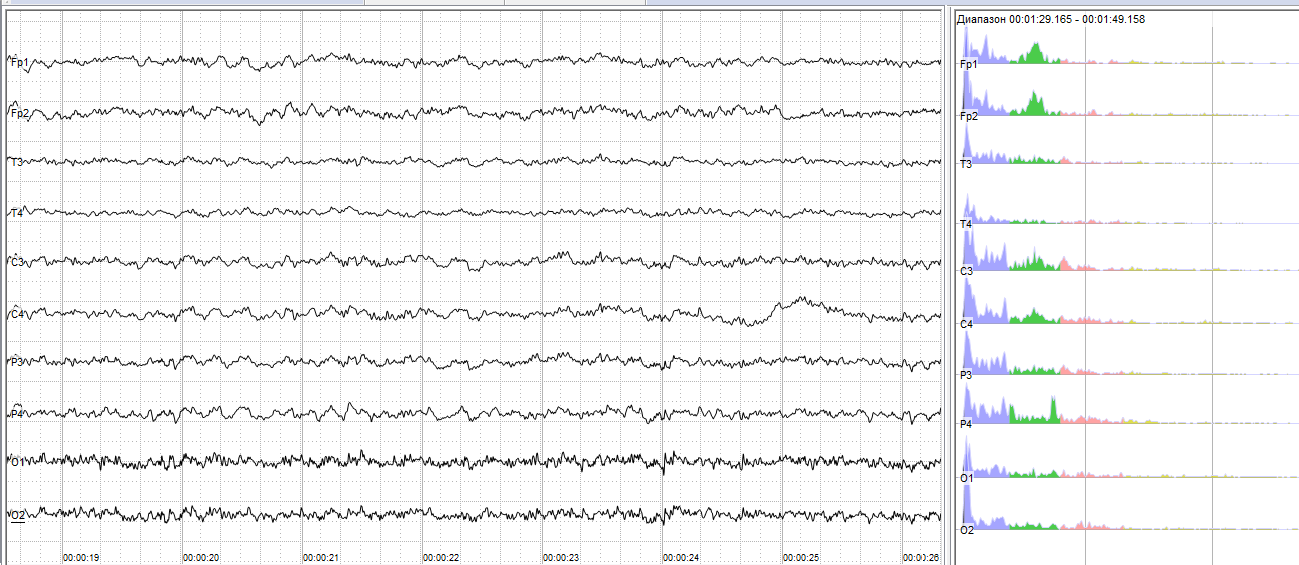Understanding the basics of Electroencephalogram
EEG - Electroencephalogram.
Let’s start with the expansion.
Electro - self explanatory.
Encephalo - the brain.
Gram - reading or a report of something.
So, we can understand that an EEG is something that helps you read the electrical activity of the brain. Various electrodes are placed at strategic points on the scalp and help to pick up these minute signals. They’re converted to wave form and printed onto paper for us to interpret.
A standard human EEG
Wait? Electrical activity of the brain?
We need to delve into the cellular level of the brain and pay a visit to the neurons. Neurons aren’t the only cells in the brain, but they’re the only cells that are responsible for the transmission of impulses, and these impulses are in the form of electrical activity. While most of the cells in our body communicate with each other through chemicals like dopamine, the neurons communicate with each other through electrical impulses. Therefore interpreting an EEG will give us an idea, how the neurons are firing in our brains — Are they firing normally? Too slowly or too fast?
Essentially, we can get an idea of the underlying neural condition of the patient by reading a simple EEG.
Next, we need to clarify a few things about what we mean by ‘electrical activity’. When describing an EEG, you may recall the terms ‘cycles per second’ or ‘voltage’ thrown around here and there. These terms aren’t used for lack of other terminology. They’re very important to understanding the neural circuitry.
- When a neuron sends an impulse, it creates some amount of electricity, so to speak, in our brains. This amount, the magnitude of electrical activity, is what we refer to as ‘voltage’. Essentially, it measures the strength of firing.
- ‘Cycles per second’. How many times has the neuron sent signals to other neurons in a second? More cycles per second, faster is the firing. It’s the frequency we’re talking about here.
Now that we’ve cleared up those concepts, let’s go a little more into detail about voltage and cycles per second in terms of an EEG.
Before I start talking about the EEG waves that are normally recorded, there is one more thing we need to know.
Synchronicity
The word itself means a state of being in union. So if a bunch of neurons are firing at the same time and in the ‘same direction’, it means they are synchronous. This is regardless of the amount of electrical activity coming from these neurons. If they are sending an impulse at the same time, they are said to be in synchronicity. For example, I throw a ball and it lands two feet in front of us. You throw a ball and it lands five feet in front us, but at the same exact time as me. The distance is different but the timing is the same. The direction is the same. Thus, we are in synch. If someone wanted to summate the total amount of effort we put into throwing balls, they would say, their total effort would be my two feet plus your five feet. However, let’s imagine this scenario. I throw the ball and it lands two feet in front of me. You throw the ball- but this time, you throw it five feet in the opposite direction. Even though we throw the balls at the same time, we aren’t in the same direction - and we are no more in synch. We are asynchronous or non-synchronous.
- If neurons fire synchronously, we can add them all up and present the final picture as, yes, this is the amount of electrical activity we have right now.
- If they fire asynchronously, what happens is that signals that have opposing polarities will end up cancelling each other.
If you’re still confused, take a glance at this equation:
§ 1 + 1 + 1 = 3
However, 1 + 1 + (-1) = 2
In the second equation, the 1 and -1 cancelled each other because they are of opposing polarities.
It’s the exact same concept that applies to calculating neuronal electrical signals.
Alright, take a breather. You need to be clear with terms cycles per second, voltage, synchronity and asynchronity. If not, that’s ok. Try to read through the examples above and you’ll get it in due time. Trust me, it is very easy to understand.
This is just a small peek into these seemingly meaningless lines. We'll get to more details in the next article.
Author: Shruthi Sivakumar
Sources and citations
Hall, John E. “States of Brain Activity - Sleep, Brain Waves, Epilepsy, Psychoses.” Guyton and Hall Textbook of Medical Physiology, 12th ed., Elsevier Saunders, 2011, pp. 723–726.

